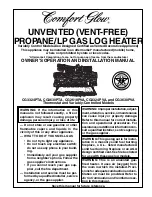
6.0 Gas Supply
(cont'd)
6.2 Gas Pressure
The main supply line pressure must be limited to 14" w.c. If the line pressure can go
above 14" w.c. (1/2 p.s.i.) at any time, a separate positive lockup, high-pressure type,
service regulator must be used. Always check local codes for gas venting requirements
for high-pressure regulators. High-pressure regulators will NOT turn off the flow of gas.
The minimum supply line pressure at the inlet to the heater regulator must, in no case,
be lower than 7" w.c. pressure for natural gas and 11" w.c. pressure for LP gas.
Gas Pressure Requirements
Type
Supply Pressure (w.c)
Manifold Pressure (at the
pressure tap in the gas valve)
Minimum
Maximum
Natural Gas
7 inches (18cm):
14 inches (35cm)
6 inches (15cm)
Propane
11 inches (28cm)
14 inches (35cm)
10 inches (25cm)
Use a water or red oil manometer when checking gas pressure. Do not use a dial
gauge. All measurements must be made when this heater and all other gas burning
equipment are operating at maximum capacity.
Natural gas models are orificed for 1000 BTU per cubic ft of gas. Propane models are
orificed for 2500 BTU per cubic ft of gas.
7.0 Electrical
7.1 Electrical Supply
WARNINGS
The heater must be electrically grounded in accordance with
the National Electric Code, ANSI/NFPA 70-latest edition, or the
Canadian Electrical Code, CSA C22.1-latest edition.
Electrical supply lines shall NOT be used to support the heater.
Do not run electrical wiring above the heater or in direct view of
radiant heat.
A heater or group of heaters can be controlled by a thermostat or manual switch. Total
load of all heaters must be considered in determining the required contact rating of the
controlling thermostat or switch.
General Requirements
• The electrical supply wiring to the heaters using 120 VAC or 24 VAC must be
installed in accordance with local codes or the National Electric Code, ANSI/NFPA
70-latest edition.
•
IMPORTANT!
The electrical power supply
MUST
be properly grounded and
properly polarized. The heater controls are extremely polarity sensitive and the
heater will cycle on and off erratically if the electrical supply is not wired correctly.
Have a qualified electrician check that the electrical supply circuit is properly
grounded and that the electrical supply polarity is correct.
• The following types of grounding are
NOT
permitted by code: grounding to building
structures, grounding to electrical conduit, grounding to gas pipelines, or grounding
to water pipelines.
• Electrical power supply must be connected to a circuit breaker or to a separately
fused circuit with a disconnect.
• Neither thermostats, nor switches, nor field wiring are supplied as standard
equipment. When a thermostat is used to control the temperature of the heated
zone, follow the wiring diagram on the unit. Position the thermostat according to
the manufacturer’s instructions.
•
Important:
In the event of an electrical fault after installation of the appliance,
preliminary system checks are required to be carried out, i.e. ground continuity,
polarity and resistance to ground, by a trained and qualified electrician.
• Make electrical connection to the heater as shown in
FIGURE 6A, 6B, or 6C.
Form I-RIH, P/N 131793R8, Page 10






































